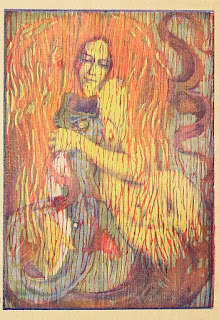Edvard Munch - Madonna, 1895/1902
"The point is that one sees with different eyes at different times. This is why a motif can be seen in so many ways and this what makes art so interesting" - Edvard Munch.
I posted recently about my discovery of the work of Norwegian artist Harald Sohlberg (1869-1935), here, and lately visited the British Museum to catch this retrospective of the print output of the most famous of Norwegian artists - Edvard Munch (1863-1944). Whilst Sohlberg concentrated on spiritual aspects of the natural landscape, Munch chose to focus on the emotional landscapes of the human condition.There is much beautiful work here, and the exhibition succeeds because of its tight focus, and for being punctuated throughout with the print ouevre of Munch's contemporaries such as Degas, Gauguin, Redon etc. inviting comparison and looking at possible influences. It being Munch of course, there just had to be a version of The Scream, his most famous and ubiquitous work, and universal image of horror and angst. Munch explored a variety of printmaking techniques and revisited and reworked his favourite themes repeatedly. My favourites were the woodcuts in which he exploited the natural grains and textures of the wood and incorporated their pattern as a feature in his prints. Munch saw a fair amount of sadness and tragedy in his life and these themes of love, jealousy, anxiety, solitude, ageing and the spectre of death are expressed in his work as a kind of personal therapy and healing. Whilst at the British Museum do make the effort to go and see the work of another master of printmaking in the display - Rembrandt: thinking on paper, on show in Room 90, as well as Symbolist Prints. Munch knew many of the Symbolist artists, and their works were very influential on his print oeuvre.
Edvard Munch - Self-Portrait with Skeleton Arm, 1895
Edvard Munch - Head by Head, 1905
I enjoyed being able to see the original woodblocks of some of the prints.
I enjoyed being able to see the original woodblocks of some of the prints.
Edvard Munch - The Kiss, 1895
Edvard Munch - The Kiss, 1902
Edvard Munch - Summer Night: The Voice, 1894
Edvard Munch - Woman in Three Stages, 1895
Edvard Munch - Attraction I, 1896
Edvard Munch - Separation II, 1896
Edvard Munch - Vampire II, 1895/1902
Edvard Munch - Man's Head in Woman's Hair, 1896
Eugène Grasset (1845-1917) - Acid Thrower, 1894
Paul Herrmann (1864-1940) - Playful Mermaid, 1897
Eugène Grasset (1845-1917) - Acid Thrower, 1894
Paul Herrmann (1864-1940) - Playful Mermaid, 1897
Edvard Munch - Woman with Red Hair and Green Eyes - Sin, 1902
Edvard Munch - Eva Mudocci/The Brooch, 1903
Edvard Munch - Eva Mudocci/The Brooch, 1903
Edvard Munch - Self-Portrait a Bottle of Wine, 1930
Paul Gauguin (1848-1903) - The Spirits of the Dead are Watching, 1893-4
Edvard Munch - The Scream, 1895

Edvard Munch - Lovers in the Waves, 1896
"For as long as I can remember I have suffered from a deep feeling of anxiety which I have tried to express in my art." - Edvard Munch, about 1908.

Edvard Munch - Lovers in the Waves, 1896
Edvard Munch - Melancholy III, 1902
Edvard Munch - Young Woman on the Beach, 1896
Edvard Munch - Moonlight I, 1896
Edvard Munch - Two Human Beings: The Lonely Ones, 1899
Edvard Munch - Angst, 1896
Edvard Munch - Angst, 1896
Edvard Munch - Death and the Woman, 1894
Edvard Munch - Two Women on the Shore, 1898
"All art, like music must be created with one's lifeblood - Art is one's lifeblood"
- Edvard Munch, 1890 -92
Edvard Munch: love and angst
until 21st July
The British Museum
Great Russell Street
London



































